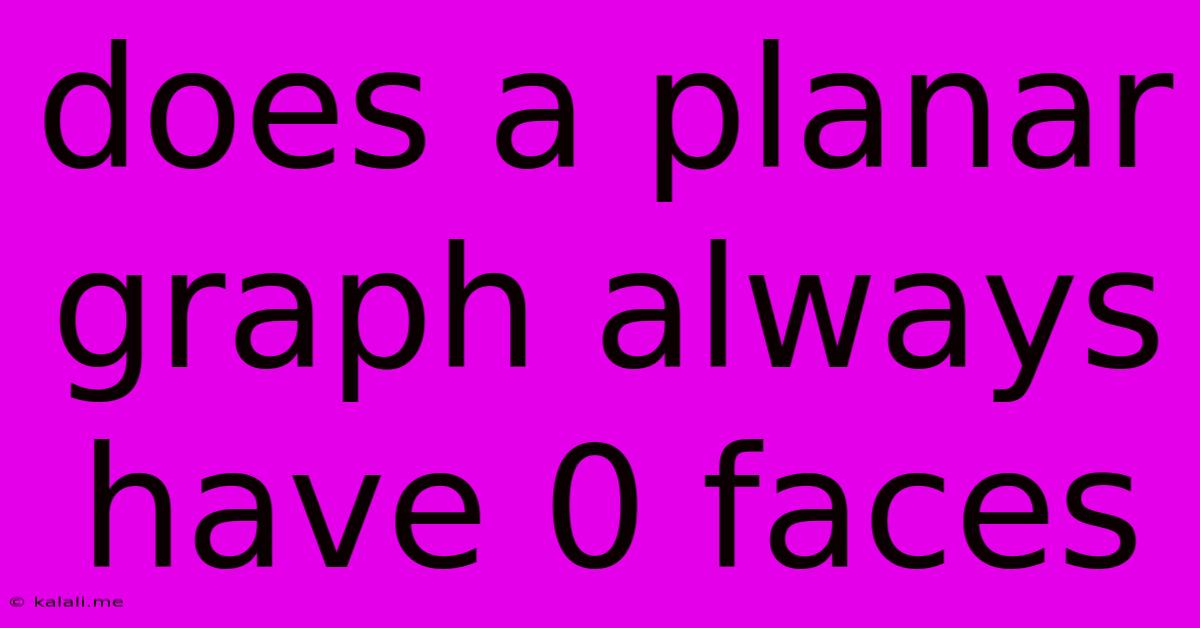Does A Planar Graph Always Have 0 Faces
Kalali
Jun 09, 2025 · 3 min read

Table of Contents
Does a Planar Graph Always Have 0 Faces? A Deep Dive into Planar Graph Theory
Meta Description: Understanding planar graphs is crucial in graph theory. This article explores the fundamental question: do planar graphs always have zero faces? We'll unravel the definition of planar graphs and their faces to answer definitively.
A planar graph is a graph that can be embedded in the plane, meaning it can be drawn on a plane in such a way that no edges intersect except at their endpoints. The question of whether a planar graph always has zero faces is a crucial one for understanding the fundamental properties of these graphs. The short answer is: no, a planar graph does not always have zero faces. Let's explore why.
Understanding Faces in a Planar Graph
A crucial element in determining the properties of a planar graph is the concept of a "face." A face is a region bounded by the edges of the graph. Think of it as the area enclosed by the edges. A planar graph embedded in the plane divides the plane into several connected regions. These regions are the faces of the graph.
- The Outer Face: One of these faces is unbounded, meaning it extends infinitely. This is typically called the outer face or the infinite face.
- Interior Faces: The other faces are bounded regions enclosed by the edges and vertices of the graph. These are the interior faces.
The number of faces a planar graph possesses is directly related to its vertices and edges through Euler's formula, which we will discuss later.
Euler's Formula and its Implications
Euler's formula for planar graphs provides a fundamental relationship between the number of vertices (V), edges (E), and faces (F):
V - E + F = 2
This formula holds true for any connected planar graph. Let's consider some examples:
- A single vertex and no edges: In this case, V = 1, E = 0, and F = 1 (the unbounded outer face). The formula holds: 1 - 0 + 1 = 2.
- A triangle: V = 3, E = 3, F = 2 (one interior face and one outer face). The formula holds: 3 - 3 + 2 = 2.
- A square: V = 4, E = 4, F = 2. The formula holds: 4 - 4 + 2 = 2.
As these examples show, a planar graph almost always has at least one face (the unbounded outer face). Therefore, the assertion that a planar graph always has zero faces is incorrect. The number of faces is dependent on the structure and complexity of the graph.
Graphs with Zero Faces – A Misconception?
The idea of a planar graph having zero faces might arise from a misunderstanding of what constitutes a "planar embedding." It's important to remember that even a simple graph like a single vertex, while planar, still defines a single, unbounded face. The presence of at least one face—the infinite face—is inherent to the definition of a planar embedding.
Conclusion
The question of whether a planar graph always has zero faces is definitively answered as no. Euler's formula and the understanding of what constitutes a "face" in a planar graph clearly show that the minimum number of faces for a connected planar graph is one – the unbounded outer face. Every connected planar graph will always have at least one face, thus refuting the initial proposition. This fundamental concept forms a cornerstone of understanding more complex properties of planar graphs.
Latest Posts
Latest Posts
-
Why Does My Toilet Make A High Pitched Noise
Jun 09, 2025
-
Proof In The Bible For Sola Fide
Jun 09, 2025
-
How Long To Par Boil Potatoes
Jun 09, 2025
-
Positive To Positive Negative To Ground
Jun 09, 2025
-
Where App Data Stored In Android
Jun 09, 2025
Related Post
Thank you for visiting our website which covers about Does A Planar Graph Always Have 0 Faces . We hope the information provided has been useful to you. Feel free to contact us if you have any questions or need further assistance. See you next time and don't miss to bookmark.